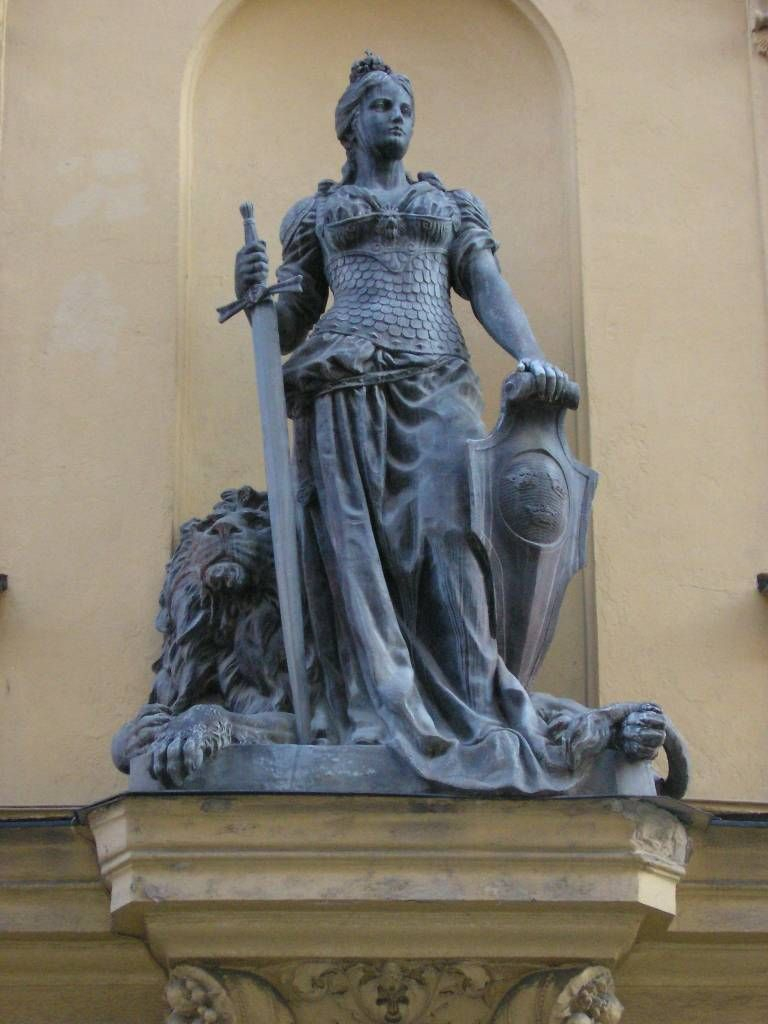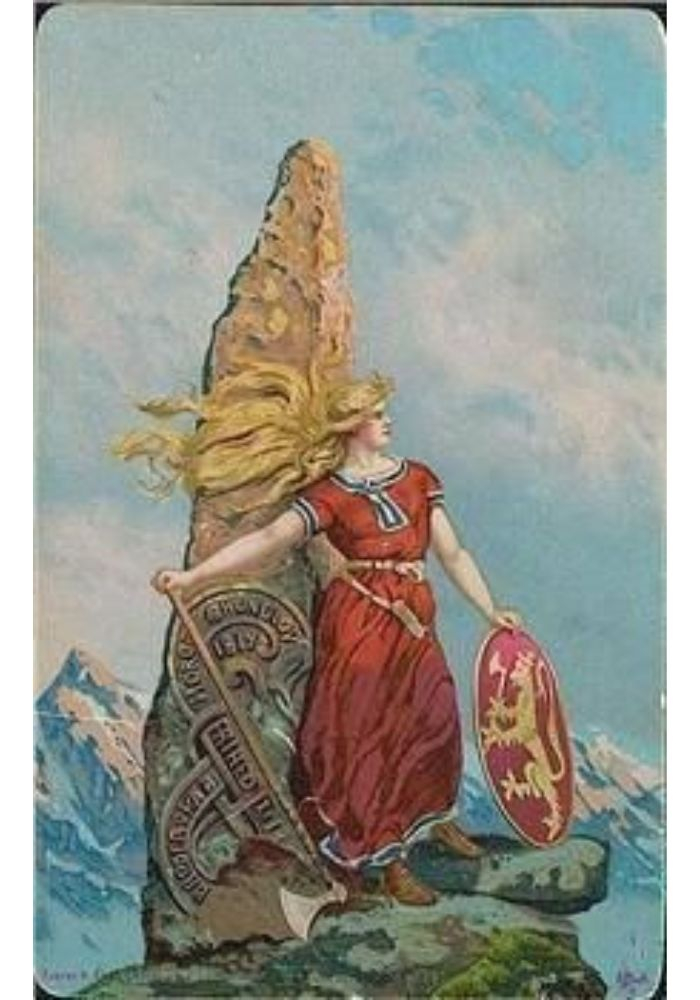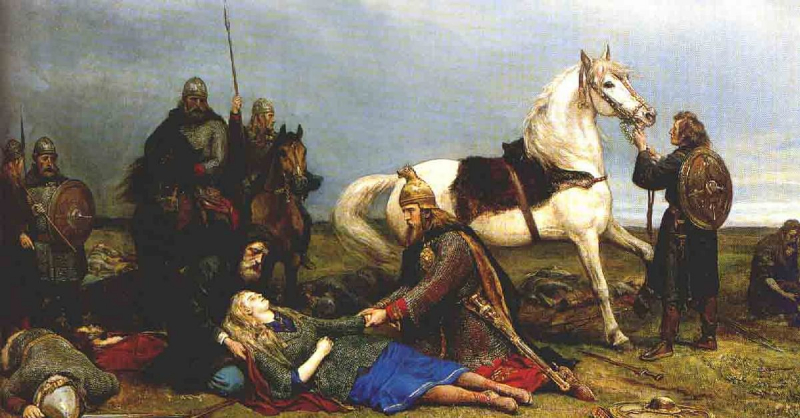Top 10 Best Female Viking Warriors in History
The study of a Viking grave found in Birka, Sweden in the 1800s CE that Charlotte Hedenstierna-Jonson and her team had investigated was published in 2017 CE by ... read more...the Uppsala University archaeologist. She asserted that DNA tests had revealed that what had previously been thought to be a Viking warrior's burial actually belonged to a woman, demonstrating the existence of female Viking fighters throughout the Viking Age (c. 790-1100 CE). Here are some of the best female Viking warriors in history.
-
The giant Thjazi's daughter, Skadi, was slain by the Asgardian deity Thor. Skadi "got helmet and all the weapons of war and marched to Asgard to revenge her father" because her father lacked any males to do it (Lindow, 268). She shows up at the gates armed and is appeased by the Asgardians' offer to let her pick her own husband from among them, but she can only do so by staring at their feet. She choose the person she believes would be the dashing Baldr, but it turns out to be Njord, the sea god.
Njord prefers his wet, gloomy cave beside the lake, while Skadi enjoys hunting and skiing, while Skadi prefers the mountains. Skadi cannot stand the compromise of staying in his house for nine days at a time, so she departs for her mountain home. She may be the mother of Freyr and Freyja, two of the most significant Norse gods, but nothing is said about her involvement in their upbringing. She pursues her own interests after splitting from Njord, which includes having several affairs with Odin.
Photo: Pinterest 
Photo: Thần thoại Bắc Âu -
One of the most well-known members of the Norse pantheon, Freyja was the goddess of protection, fertility, good fortune, love, lust, and the afterlife and one of the best female Viking warriors in history. She gladly gives of whatever she has to humanity as she travels through the heavens in a cat-drawn carriage. She was revered by the Vikings as a fertility goddess and was called for bountiful harvests as well as for healthy children and happy marriages, which were supposed to benefit from her blessings.
Her connection to combat and conflict has to do with her afterlife realm. It is stated that Freyja, who rules over Fólkvangr (also known as "Field of the People"), gathers half of the casualties from battle for herself, with the other half being gathered by Odin for Valhalla. Despite the fact that Fólkvangr is rarely addressed in works of Norse literature, what little there is suggests that Freyja may also watch while soldiers engage in never-ending combat—or at the very least, that there is a portion of Fólkvangr set aside for such battles.
Photo: All About History Photo: See U in History / Mythology -
After siding with the wrong hero in a battle watched by Odin, Brynhild (also known as Brynhildr, Brunhild, Brunhilde, or Brunhilda) is a Valkyrie who is turned mortal and imprisoned in a castle behind a wall of shields, dozing within a ring of fire, until she is freed by a champion. After saving her, the brave hero Sigurd presents her with a ring and declares his intention to wed her, but only after visiting the court of King Gjuki. A sorceress who is Gjuki's wife offers Sigurd a potion that makes him forget about Brynhild because she wants him to marry her daughter Gudrun.
The witch also arranges for her son Gunnar to save Brynhild so that she might be married, but Gunnar is unable to pass the ring of fire. Brynhild is saved by Sigurd, who transforms into Gunnar, and she marries Gunnar, thinking he was the one who saved her. Brynhild learns from Gudrun during their quarrel that it was Sigurd who initially saved her but abandoned her, and she swears vengeance on them all. She murders Sigurd's young boy before having Sigurd assassinated as he slept. She jumps into the funeral pyre as it is lit and passes away alongside him. A giantess chastises Brynhild for her actions as they travel to the afterlife in Hel with him, but she is unrepentant and declares that she and Sigurd will now enjoy their lives together as they were meant to. She is one of the best female Viking warriors in history
Photo: BaviPower 
Photo: DeviantArt -
Only Chapter IX of Saxo Grammaticus' Gesta Danorum (commonly known as "History of the Danes") contains information about Lagertha (also known as Ladgerda). Ragnar Lothbrok, a legendary warrior, travels to Norway in order to exact revenge on the Swedish king for killing his grandfather Siward and humiliating his wives and relatives. In Saxo's words, "...among them was Ladgerda, a competent female warrior who, while a girl, had the courage of a man and battled in front among the bravest with her hair loose over the shoulders. They all offered to help him." Everyone was in awe of her peerless accomplishments since her flowing hair down her back revealed her gender.
She makes Ragnar so impressed that he chooses to make her his bride (he even directly credits her with the victory), but Lagertha has a bear and a hound posted outside her home as security against him. Ragnar kills the two creatures, marries her, and they have two kids together. However, later, when he realizes that she attempted to provoke the dog and bear into attacking him, he gets a divorce from her and marries Thora. About Lagertha, nothing else is known.
Photo: Wikipedia 
Photo: BLADE HONER - WordPress.com -
Hervor is both the name of her granddaughter, who is the daughter of her son Heidrek, and the protagonist of the Hervarar epic, which dates back to the 13th century CE. Tyrfing was a magic sword owned by Hervor's father, Angantyr, who was killed in a duel and had the sword buried with him. Hervor takes her crew to the Kattegat region's island of Sams, where Angantyr is interred, and invokes his soul to obtain the sword. The ghost of her father begs her to give up, but she will not budge. The mystical blade is presented to her after he finally unlocks his grave.
Hervor experiences a series of adventures before settling down and getting married, and the sword only causes its owner difficulty. The sword is given to her son Heidrek, who experiences the same issues it did with his mother. His daughter Hervor receives the sword after his passing, but she perishes in combat. Hervor's defiance of convention and persistence in demanding what she came for at her father's grave are the most stunning aspects of the story.
Photo: Berloga Workshop 
Photo: Maren Montalbano -
Depending on which of the two accounts of Freydis Eirksdóttir (c. 970-c. 1004 CE) one reads, she was either a heroic woman warrior or a wicked and also one of the best female Viking warriors in history, cunning murderer. She appears in The Saga of the Greenlanders and Erik the Red's Saga, in which she plays the lead role (a villainess). Freydis, the daughter of Erik the Red, travels to Vinland with a group in Erik the Red's Saga (Newfoundland, North America). When some locals attack them, the guys in the party flee, leaving Freydis to defend herself. "Why run you away from such worthless creatures, stout men that ye are, when, as it seems likely to me, you would slaughter them like so many cattle?" she cries out to them. If I had a weapon, I believe I could fight more effectively than any of you (Chapter 12). Freydis, despite being sick (perhaps pregnant) and alone herself, seizes a sword from a fallen friend and, after ripping open her shirt and striking her breasts with the blade, challenges the adversary, who flees, sparing her group.
She travels to Vinland with her husband, his soldiers, and two brothers/business partners in The Saga of the Greenlanders. She accuses the brothers of abusing and beating her and threatens to divorce her husband if he doesn't take revenge because she dislikes them and thinks they are arrogant. Freydis uses an axe to murder all the women after her husband and his soldiers kill the brothers and their party but refuse to harm the women. It's possible that this second story, which was created after the first, is an effort to disparage the powerful female protagonist from the first. Freydis has a greater chance of reflecting an actual historical person than the more obviously mythological and legendary characters discussed above because it is generally believed that these two sagas that refer to Vinland remember real people and events that were at least partially preserved through an oral tradition.
Photo: Muy Historia 
Photo: twitter.com -
According to Erik the Red's Saga and The Saga of the Greenlanders, one of the earliest explorers of North America was Gudrid Thorbjarnardóttir (born c. 970/980 CE). She was originally from Iceland, but she traveled to Greenland with her father and Erik the Red. Following the passing of her husband in Greenland, she quickly wed Thorstein, the younger brother of Leif Erikson, and traveled to North America with her husband and brother-in-law to explore Vinland.
Thorstein passed away there, and Gudrid went back to Greenland where she married a man named Thorfinn Karlsefni. She then went back to Vinland with him to start a permanent settlement there. The first European born in North America was their son, Snorri Thorfinnsson. The Gudrid of the sagas is probably based on a real-life historical figure, like Freydis.
Photo: The Guardian 
Photo: Wikipedia -
Sigrid the Proud, also known as Sigrid the Haughty, Sigr Storrda, or Sigrid Tostadottir, was a Swedish monarch who defied social convention. She lived from from 927 until approximately 1014 CE. Erik the Victorious, king of Sweden (c. 970–995 CE), was her husband, although she opted to rule alone after he passed away. She was courted by Vissavald of the Kievan Rus and Harald Grenske of Norway, but she realized they were simply after her for her land and fortune. To deter other suitors, she brought them to a party where, after they and their men passed out from drinking too much, she barred the doors and burnt them to death. Her historical veracity is in question, so this juicy tale might just be a myth.
She was reputedly sought after by the notorious Olaf Tryggvason (r. 995–1000 CE), who forced Norway's people to become Christians by torturing them, but he requested she become a Christian first. He slapped her in front of everyone when she refused, and Sigrid promised retaliation. The Battle of Svolder, where Olaf was killed, is supposed to have been planned by her after she wed Sweyn Forkbeard for his connections and influence.
Photo: Kroniki Dziejów 
Photo: Pinterest -
Another best female Viking warrior in history, Unn the Deep-Minded, also known as Aud the Deep-Minded and Unn- or Aud Ketilsdóttir, was a Norwegian nobleman who fled to Scotland after Harald Fairhair (r. 850–933 CE) rose to power. She was the daughter of Ketil Flatnose. She knew her situation in Scotland was perilous after the deaths of her father and her son Thorstein, so she initially traveled to the northern Orkney Islands before moving to Iceland, where she later settled. She oversaw a group of men who were so devoted to her that none would agree to unions that would endanger Unn's possessions or position.
She practically ruled her family and lands in southern Iceland until the day she passed away. She oversaw the setup and service on the day that her grandson Olaf Feilan got married, and she then made a dignified retreat to her bedroom, where she passed away peacefully.
Photo: Pinterest 
Photo: World History Encyclopedia -
St. Olga of Kievan Rus is a more popular name for Olga of Kiev, who died in 969 CE. Although she is undoubtedly recognized as a real historical person, the Russian Primary Chronicle, written around 1113 CE, contains a number of mythic/legendary elements that place her among the legendary female Viking (Varangian) warriors during her early reign as regent for her son Sviatoslav I (r. 945–972 CE).
Olga was the spouse of Igor of Kiev (r. 912–945), who was the adoptive son of Oleg the Prophet and the son of Rurik (r. 862–879 CE) (r. 879-912 CE). Igor's overwhelming greed led to the Drevlian tribe assassinating him (a tribe of Early East Slavs). The Drevlians then desired Olga to wed their prince Mai in order to unite the area, but Olga was only concerned with exacting revenge on her murdered husband.
She duped Drevlian messengers into being transported "with honor" in a boat near her residence before ordering them to be dumped into a pit and buried alive. She then sought emissaries from the Drevlians. She then invited the most wise of the Drevlians to her palace, where she burned them alive after inviting them to take a bath before dinner. She then ordered the Drevlians to arrange an elaborate funeral feast in memory of Igor, which she afterwards had her soldiers murder.
She drove the Drevlians into the city of Iskorosten, where Igor had been slaughtered, as her final act of retaliation, and then laid siege. She demanded three pigeons and three sparrows from each residence after realizing she could not conquer the city on her own. When these arrived, she had her soldiers attach sulfur to their claws, release them, and when they went back to their nests in the city, they started a fire that spread over the entire city. Olga spared a specific number so they could continue to pay her homage even when the entire city burned down and those who survived were slaughtered or sold into slavery.
Photo: History Collection 
Photo: All That's Interesting































